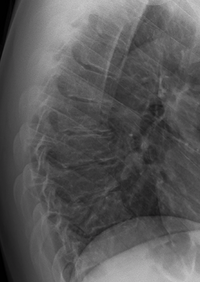
Photo from wikipedia
Background: The thoracolumbar junction (TLJ) represents a transition zone of the spine that leads to a high incidence of fractures. The treatment of burst fractures remains controversial regarding the ideal… Click to show full abstract
Background: The thoracolumbar junction (TLJ) represents a transition zone of the spine that leads to a high incidence of fractures. The treatment of burst fractures remains controversial regarding the ideal management. This study assessed the postoperative radiological outcome of TLJ fixation in patients with TLJ injuries who underwent surgery. Methods: All traumatic patients with TLJ injuries who were referred to the Khatam hospital of Zahedan between 2015 and 2020, with their thoracolumbar injury classification and severity score (TLICS) of four or more and who underwent surgery, were included in this study. The patients who entered the study were called for a follow-up examination. The degree of kyphosis, proximal junctional kyphosis, and fusion were assessed in these patients. Results: Among 273 patients, the average age was 43.5 ± 12.3 (21–73) years. One hundred and ninety-eight patients (72.5%) had no neurological symptoms at admission. Based on the above criteria, the kyphosis angle of these patients was calculated before surgery, which in 46 patients (16.8%), the kyphosis angle was more than 25°. Preoperation kyphosis was significantly associated with follow-up kyphosis (P < 0.001). Evidence of no fusion was also observed in 22 patients (8.1%). According to the Chi-square test, no association was observed between preoperative kyphosis and postoperative complications, including PJK and fusion (P > 0.05). Conclusion: According to our study, the posterior spinal fixation procedure is a low-complication method with an acceptable radiological outcome. Although kyphosis before surgery is a factor in developing long-term kyphosis, it is not associated with nonfusion and PJK.
Journal Title: Surgical Neurology International
Year Published: 2022
Link to full text (if available)
Share on Social Media: Sign Up to like & get
recommendations!